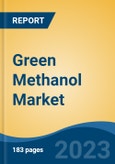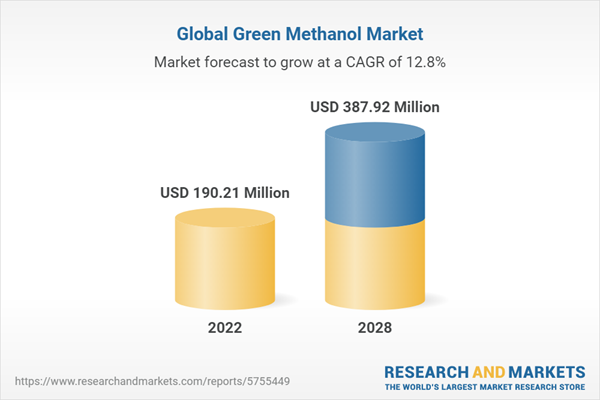Free Webex Call
The global green methanol market is anticipated to grow significantly at a CAGR of 12.82% and reach approximately USD 387.92 million in 2028, due to the growing awareness towards global warming and increasing demand of eco-friendly fuel. In 2021, global carbon dioxide emissions from fossil fuels and industry were 33.67 billion metric tonnes. Speak directly to the analyst to clarify any post sales queries you may have.
10% Free customizationThis report comes with 10% free customization, enabling you to add data that meets your specific business needs.
Green methanol is a sustainable source which can be used for various application like fuel source, feedstock for various chemical industries and as a renewable energy storage solution. The basic advantages of green methanol as an energy storage medium are its scalability and ease of transportation. Unlike conventional batteries, which have limited storage capacities and are bulky, green methanol can be stored in large quantities and transported using existing infrastructure. This scalability makes it an attractive solution for both small-scale and large-scale energy storage applications, enabling the integration of renewable energy into various sectors. Due to these benefits, the demand for green methanol increases, which dominate the growth of global green methanol market in the upcoming years.
Growing Utilization of Green Methanol in Chemical Sector
In recent years, concerns about climate change and environmental sustainability have led to a growing interest in cleaner and greener alternatives across industries. The chemical industry, a major contributor to global greenhouse gas emissions, is actively seeking more sustainable solutions to meet the demand for chemicals while reducing its environmental impact. Among the promising alternatives, green methanol stands out as a key player in transforming the chemical industry.Methanol is a versatile chemical used in numerous industrial processes, has been traditionally produced from fossil fuels, contributing significantly to greenhouse gas emissions. In addition, green methanol is produced using renewable energy sources and sustainable feedstocks, making it carbon-neutral or carbon-negative fuel. The primary sources of green methanol are biomass, captured carbon dioxide (CO2), and waste gases from industrial processes. One of the most significant advantages of green methanol is its potential to drastically reduce the carbon footprint of the chemical industry. Traditional methanol production emits substantial amounts of CO2, contributing to global warming. Green methanol production, on the other hand, recycles CO2 from the atmosphere or industrial emissions, effectively closing the carbon loop and making it an environmentally friendly option. For instance, in 2022, Green Umia project estimates to achieve a reduction of 58,000 tonnes of CO2 during its first 10 years of operation, as a result of the production of 2,900 tonnes per year of renewable methanol, which will be used by Foresa itself for incorporation into a wide variety of industries.
Moreover, conventional methanol production relies heavily on fossil fuels such as natural gas, coal, and petroleum, which are finite resources. In contrast, green methanol can be produced from a wide range of sustainable feedstocks, including agricultural waste, forestry residues, municipal solid waste, and even carbon dioxide captured from industrial processes. It reduces pressure on fossil fuel reserves and help in managing waste and controlling pollution. Furthermore, green methanol is used as a feedstock for the production of various chemical products. These chemical products are used in different verticals like transportation, construction, pharmaceutical, fertilizers and so on. The generation of formaldehyde used in paint and coating industries, Methyl-tert-butyl-ether is help in the production of biodiesel which helps to increase the use of biodiesel as alternative fuel, dimethyl ether is used as chemical solvent. The production of such chemicals helps in reducing the emission of carbon footprints and results in a green environment.
Additionally, green methanol production has seen significant advancements in technology and process efficiency. New catalytic processes and innovative reactor designs have led to higher yields and reduced energy consumption, making it a more economically viable and attractive option for the chemical industry. As these technologies continue to develop, the production cost of green methanol is expected to decrease, further accelerating its adoption. Thus, increasing awareness regarding the utilization of green methanol as a sustainable feedstock in replacement of conventional feedstock in chemical industries witness substantial growth of Global Green Methanol market in the upcoming years.
Increasing Demand for Green Methanol as Renewable Energy Storage Solution
In the pursuit of a sustainable future, renewable energy sources have emerged as a crucial component of the global energy landscape. However, harnessing the full potential of renewables like solar and wind energy presently has challenges, including intermittent generation and the need for efficient energy storage solutions. Green methanol has emerged as a promising alternative to address these challenges, revolutionizing renewable energy storage and contributing to the decarbonization of energy systems.Renewable energy sources like solar and wind offer a clean and abundant energy supply. However, their variability presents a challenge when it comes to matching energy production with demand. Solar power is available during daylight hours, and wind turbines generate electricity based on wind speed, which can be unpredictable. As a result, excess energy is often produced when demand is low, and energy shortages can occur during peak demand periods. In contrast to this, green methanol has emerged as an optimal solution for renewable energy storage due to its ability to act as a versatile energy carrier. Through a process known as Power-to-Methanol (PtM), surplus renewable energy can be utilized to produce green methanol by converting carbon dioxide and hydrogen. The produced green methanol can then be stored and utilized when needed, effectively storing renewable energy in a chemical form. For instance, in 2023, according to Ministry of Power in India, NTPC Green Energy Ltd. (NGEL) and HPCL Mittal Energy Ltd. (HMEL) signed a MoU for collaboration in renewable energy through sourcing of 250 MW RE-RTC (Round-The-Clock) power to meet the requirement of HMEL and exploring opportunities in the green hydrogen business & its derivatives (green ammonia & green methanol).
Moreover, green methanol has high compatibility with existing energy infrastructure. It can be blended with traditional fossil fuels and used in internal combustion engines or converted into electricity through fuel cells. This compatibility eases the transition to renewable energy while utilizing the existing energy distribution and transportation networks. Therefore, increasing use of green methanol as renewable energy storage solution led to the growth of global green methanol market in the forecast period.
Adoption of Strict Environmental Regulations to Reduce Carbon Emission Impact
As the world faces urgent challenge of combating climate change, stringent environmental regulations have become a critical tool in reducing carbon emissions and their impact on the environment. The use of green methanol is among the innovative solutions emerging to address this global concern. Green methanol, produced from renewable sources and carbon capture technologies, offers a promising pathway to minimize carbon emissions. Green methanol has the potential to replace traditional fossil fuels in various sectors. Stringent environmental regulations can encourage the integration of green methanol as a low-carbon fuel in transportation, shipping, and power generation. by adopting green methanol as an alternative to conventional fuels, carbon emissions from these industries can be reduced, contributing to global efforts to combat climate change. For instance, in 2023, EPA proposed Clean Air Act emission limits and guidelines for carbon dioxide (CO2) from fossil fuel-fired power plants based on cost-effective and available control technologies.Moreover, green methanol can be produced using carbon capture and utilization (CCU) technologies. These technologies capture carbon dioxide emissions from industrial processes and convert them into valuable products like green methanol. Stringent environmental regulations can support the adoption of CCU technologies, encouraging industries to invest in carbon capture infrastructure and facilitate the conversion of captured carbon dioxide into sustainable methanol. Thus, rising strict environmental regulations regarding the emission of CO2 and converting it into sustainable products such as, green methanol driving the growth of global green methanol market in the projected years.
Market Segmentation
Global green methanol market is segmented based on feedstock, type, application, and region. Based on feedstock, the market is divided into CO2 emissions, municipal solid waste, agricultural waste, forestry residues, and others. Based on the type, the market is categorized into e-methanol and bio-methanol. Based on application, the market is segmented into fuel grade, chemical feedstock, and others. Based on region, the market is divided into Europe, North America, Asia-Pacific, and rest of the world.Company Profiles
OCI N.V., Methanex Corporation, Enerkem Inc., Carbon Recycling International, Södra Skogsägarna, BASF SE, Topsoe A/S, Liquid Wind AB, Eni S.p.A., ABEL Energy Pty Ltd., Thyssenkrupp AG, Nordic Green ApS, Mitsubishi Gas Chemical Co Inc, Southern Green Gas Limited, and SunGas Renewables Inc. are some of the key players of global green methanol market.Report Scope
In this report, the global green methanol market has been segmented into the following categories, in addition to the industry trends, which have also been detailed below:Green Methanol Market, by Feedstock
- CO2 Emissions
- Municipal Solid Waste
- Agricultural Waste
- Forestry Residues
- Others
Green Methanol Market, by Type
- E-Methanol
- Bio Methanol
Green Methanol Market, by Application
- Fuel Grade
- Chemical Feedstock
- Others
Green Methanol Market, by Region
- Europe
- North America
- Asia-Pacific
- Rest of the World
Competitive Landscape
Company Profiles: Detailed analysis of the major companies in the global green methanol market.Available Customizations
The following customization option is available for the report based on your specific needs: Detailed analysis and profiling of additional market players (up to five).Table of Contents
1. Product Overview2. Research Methodology3. Impact of COVID-19 on Global Green Methanol Market4. Executive Summary12. Market Trends & Developments13. Global Green Methanol Market: SWOT Analysis14. Porter’s Five Forces Analysis16. Strategic Recommendations
5. Voice of Customer
6. Global Green Methanol Market Outlook
7. Europe Green Methanol Market Outlook
8. North America Green Methanol Market Outlook
9. Asia-Pacific Green Methanol Market Outlook
10. Rest of the World Green Methanol Market Outlook
11. Market Dynamics
15. Competitive Landscape
List of Figures
Companies Mentioned
- OCI N.V.
- Methanex Corporation
- Enerkem Inc.
- Carbon Recycling International
- Södra Skogsägarna
- BASF SE
- Topsoe A/S
- Liquid Wind AB
- Eni S.p.A.
- ABEL Energy Pty Ltd.
- Thyssenkrupp AG
- Nordic Green ApS
- Mitsubishi Gas Chemical Co Inc
- Southern Green Gas Limited
- SunGas Renewables Inc.
Table Information
| Report Attribute | Details |
|---|---|
| No. of Pages | 183 |
| Published | October 2023 |
| Forecast Period | 2022 - 2028 |
| Estimated Market Value ( USD | $ 190.21 Million |
| Forecasted Market Value ( USD | $ 387.92 Million |
| Compound Annual Growth Rate | 12.8% |
| Regions Covered | Global |
| No. of Companies Mentioned | 15 |









